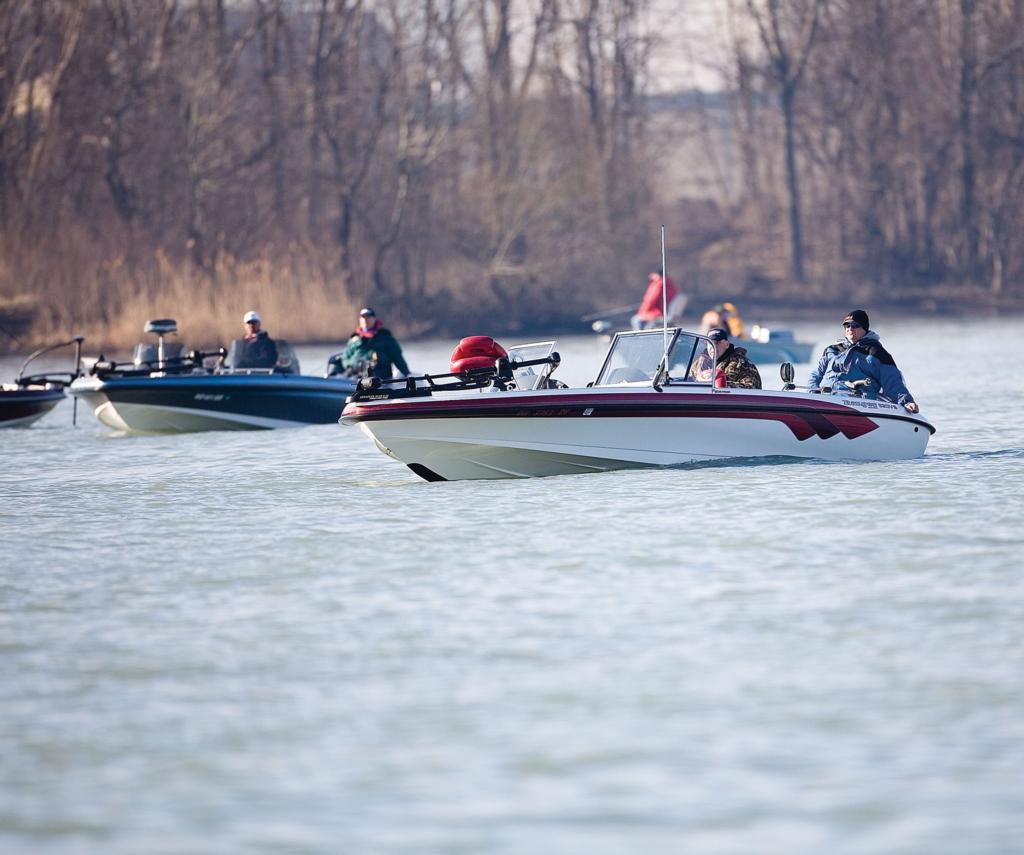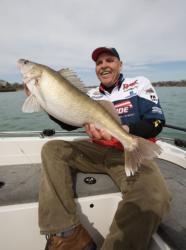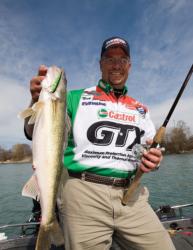The dirt on catching river walleyes
Point-blank presentations for ’eyes in the mud

Tournament schedules force some of the best anglers in the world to fish throughout the season, regardless of conditions. With the actual dates for the tournaments set months in advance, anglers must deal with extremes in temperature, water clarity and fish activity. For many anglers, river systems are a favorite destination to begin each new season. Wherever walleyes may roam, river systems offer a predictable pattern as fish travel and concentrate to spawn. What aren’t predictable, however, are weather and river conditions.
Nothing will shut down a hot river bite like high runoff and no visibility. Four inches of snow or rain can muddy the water and literally shut down the bite for weeks. For many river rats, the best way to catch walleyes under such conditions is to pack up and fish somewhere else. For the professional anglers that follow the tournament trail, however, packing up and traveling to a better bite isn’t an option. These anglers are forced to make adjustments and alter their approach. Catching walleyes when visibility is reduced to an inch is difficult, but certainly not impossible.
Richard LaCourse of Port Clinton, Ohio, has years of experience fishing rivers, including muddy ones. Regarding muddy-water techniques, LaCourse treats them just like any other tough fishing situation when the walleyes turn finicky, such as a cold front. He begins by downsizing his presentation, and then slows everything down.
In a muddy river combined with swift current, such as the Detroit River at times, LaCourse advocates handlining and polelining. “Pulling my handline into the current allows me to stall a bait while the current keeps it working right in front of a fish,” LaCourse said. “A walleye’s sight is very limited in dirty water, so they’re not going to chase a bait 5 feet. But they’ll feel the vibration of it and bite it out of reaction if it’s right in front of them.”
 The more current there is to work the lure, then, the more effective handlining can be. “It’s not rocket science,” LaCourse said. “It’s just an effective way of presenting a bait in muddy water and heavy current.”
The more current there is to work the lure, then, the more effective handlining can be. “It’s not rocket science,” LaCourse said. “It’s just an effective way of presenting a bait in muddy water and heavy current.”
When it comes to choosing just the right offering to twitch and pulse at the end of a handline, experimenting with various crankbaits once you’ve settled on handlining as your technique is the key. Most of the time, in muddy water, the brighter colors, such as orange, chartreuse and firetiger, will produce the best.
The tight wobble of a classic Rapala Floating Minnow is often the lure of choice for a handlining presentation, but diving plugs, particularly shallow-running Shad Raps, are also useful for this technique. LaCourse progressively downsizes his offerings as conditions worsen and walleye lips seal a little tighter. Fish that were hitting a No. 9 Shad Rap might open up more willingly for a No. 5 Shad Rap as the water gets colder, faster and muddier.
Tommy Skarlis of Dorchester, Iowa, has spent a considerable amount of time slipping the current on walleye runs across the continent. A seasoned professional angler who is one of the most consistent anglers on the Wal-Mart FLW Walleye Tour, Skarlis has an uncanny ability to scratch out walleyes regardless of conditions.
Skarlis approaches any river system very observantly. His quest for finding “clean” water in a flow of chocolate milk even takes place on the Internet, in some instances right up until he leaves for the destination.
“On some river systems, like the Detroit River for example,” Skarlis explained, “I can go on the Internet and look at recent aerial photos to try and distinguish if there are pools or pockets of cleaner water. Sometimes, one side of the channel might be better.”
What Skarlis tries to establish immediately is where the dirty water is coming from. “If the main channel is high from runoff, for example, and visibility is poor, I look for feeder creeks or some other source that might be dumping cleaner water into the channel. This pocket of clean water might afford me a small area with better visibility. If the stained water is coming into the main channel from a tributary or from immediate runoff, I often try and get above the source, upstream where the water is often clearer.” Skarlis spends much of his prefishing time narrowing down small pockets of water that offer the best visibility when conditions get bad.
Water visibility can often be determined by how soon your jig disappears in the water. In some cases, bad visibility might make a 1/2-ounce jig vanish when lowered a couple of inches. Skarlis is actually planning on marking the shaft and lower unit of his Minn Kota 101 with a chartreuse ruler for monitoring water clarity more precisely for the 2006 season.
While popular in bass circles, dipping plastics in fish attractant formulas isn’t as common amongst the walleye crowd. Skarlis, however, insists added scent can make a difference under tough river conditions. Skarlis often dips his jig into Berkley Walleye Attractant every couple of minutes.
“Bait, however, isn’t as crucial,” Skarlis added, “when you are using scented plastics.” The beauty of plastics is that they don’t tear off after a bite as easy and come in the shapes and colors needed to catch walleyes in dirty water.
When bulking up with longer profiles, Skarlis also attaches a stinger hook to the rear of his bait. Dirty water means fishing slow, and to slow down in the current, anglers are forced to go heavier. But heavier jigs with bulked-up bodies can mean short hits so a stinger hook can be important.
“One extreme or the other” is how Skarlis described his preferred color options. Fluorescent, glow and chartreuse are popular choices, but many river anglers, Skarlis included, experiment with dark color options, like purple or black.
Under such conditions, anglers seldom have to worry about walleyes spooking from under the boat, and the presentation is kept vertical even when targeting shallow fish. Some anglers choose to anchor and pound the jig in one spot, picking off fish as they move through. Other anglers slip slightly slower than the current. Whether you anchor or slip, pounding the bottom is extremely important. “You don’t want the jig to move horizontally very much, but you need to pound the jig on the bottom vertically so that fish can find you,” Skarlis explained.
 Another accomplished river angler, Nick Johnson of Elmwood, Wis., echoes many of Skarlis’ opinions regarding river walleyes during high-water/reduced-visibility conditions. Johnson, who won the coveted FLW Walleye Tour Angler of the Year Title during the 2005 season, is very proficient on moving water.
Another accomplished river angler, Nick Johnson of Elmwood, Wis., echoes many of Skarlis’ opinions regarding river walleyes during high-water/reduced-visibility conditions. Johnson, who won the coveted FLW Walleye Tour Angler of the Year Title during the 2005 season, is very proficient on moving water.
Like Skarlis, Johnson has fallen in favor of jig and soft-bait combinations for most of his river fishing. Both anglers prefer the Berkley Gulp! and Powerbait bodies for added color, scent and profile when the visibility is reduced. Both anglers also choose color extremes as well. Johnson often favors black or purple but also experiments with brighter colors in glow, chartreuse or white, especially when fishing shallow.
Johnson stresses that he focuses his attention on the edges more during strong flows that often coincide with dirty water. “Usually, really strong current will blow the walleyes out of the main channels, but you can still usually find saugers holding right in the main flow,” Johnson explained.
When targeting walleyes, especially bigger fish, Johnson focuses on the edges away from the main channel and fishes shallow. Often times, Johnson will find walleyes holding to backwater areas that were nothing more than duck marshes before the high water. Other structural elements Johnson looks for are flooded willow stands or riprap areas that lead to backwater. He notes these shallow areas away from the main channel often offer better visibility and hold aggressive fish feeding on shad, shiners and other baitfish, whether the fish are in prespawn or postspawn.
When targeting river fish in less than 6 feet of water, Johnson spends a lot of time casting and working the jig back to the boat. “Many times, fish aren’t chasing the bait so you have to work the bait slowly or you won’t get bit,” Johnson said.
Johnson prefers to cast because he believes he can come into contact with more fish by working cross-current and often finds walleyes in extremely shallow water. “There are times,” Johnson explained, “when we are literally casting the jig up onto shore and bringing it back.”
When Johnson is forced to work with the main channel where flows are often at their strongest, he often chooses to slowly motor upstream or cross-current with three-way rigs and stickbaits. “Usually, saugers are going to hold in their wintering holes no matter how bad the current gets and these deep holes will often hold male walleyes as well,” Johnson said. “It takes an awful lot of current to blow saugers out of these spots.” In strong current, weights that range between 3 and 5 ounces, sometimes more, are used to sink a three-way rig with about a 4-foot snell.
Johnson stresses that you want a long, easy-to-find profile that doesn’t dive too deep when choosing the proper stickbait. Crankbait options might include a No. 11 Original Floating Rapala, Smithwick Rattlin’ Rogue, Berkley Frenzy Firestick Minnow or Salmo 8F Perch. By hovering upstream and cross-stream with a three-way rig, Johnson can actually move much slower than slipping downstream with a jig, giving the fish more time to find the lure. Like casting cross-stream, Johnson stresses that he can often get his lures in front of more fish by slowly cutting across the current breaks, moving cross-stream. This tactic enables him to crawl through productive areas at a snail’s pace, putting a vibrating, attractive profile in front of the fish for longer periods of time.